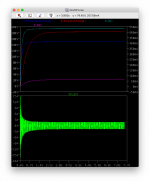An alternative here.
The front ends are 200V B+ total max of 80mA. The output sections are 150V B+ at 420mA total maxed. So I'm wondering if it's better to use 117 secondaries in parallel (117V @ 2.56A) for more current, voltage double the front (now 160mA max) and then run 165V with large caps to reduce the drop.
I'll try a model on this later today.
Last option is simply go 500VA but the drastic requirements are really down to the spikey non-PFC coupled with the passive res LPF..
The front ends are 200V B+ total max of 80mA. The output sections are 150V B+ at 420mA total maxed. So I'm wondering if it's better to use 117 secondaries in parallel (117V @ 2.56A) for more current, voltage double the front (now 160mA max) and then run 165V with large caps to reduce the drop.
I'll try a model on this later today.
Last option is simply go 500VA but the drastic requirements are really down to the spikey non-PFC coupled with the passive res LPF..
Ok, so I have made a combined parallel secretary bridge and voltage doubler. I've made a simple model, then used a LPF passives and finally a dummy load to ensure the current at the voltage - just to see what it could support and what is the final draw through the secondaries.

Top - 180V @ 80mA and 150V @ 500mA then bottom, the current through one of the secondaries.
Current peak during the normal operation is 1.64A as a spike. Or 3.4A total spikes from both secondaries. The hammond 300VA supports 1.36A or 2.72A both max.. way way short once you add in the passive LPFs. If I look at the FFT of the B+ lines there's still a load of noise at 100Hz for the output stage, so I need more voltage to drop if I was to use a passive LPF.
The 234V 500VA with 117V secondaries on the other hand supports 2.14A on each secondary or 4.28A in parallel.
I have plans to move towards a PP version of the headphone amp OTL, but then look at 2a3 by removing one ecc99 (120mA) and then making the single ecc99 left run as the driver for the 2a3 (80-180mA) at 250V would probably mean a rethink of the power-output needed.

Top - 180V @ 80mA and 150V @ 500mA then bottom, the current through one of the secondaries.
Current peak during the normal operation is 1.64A as a spike. Or 3.4A total spikes from both secondaries. The hammond 300VA supports 1.36A or 2.72A both max.. way way short once you add in the passive LPFs. If I look at the FFT of the B+ lines there's still a load of noise at 100Hz for the output stage, so I need more voltage to drop if I was to use a passive LPF.
The 234V 500VA with 117V secondaries on the other hand supports 2.14A on each secondary or 4.28A in parallel.
I have plans to move towards a PP version of the headphone amp OTL, but then look at 2a3 by removing one ecc99 (120mA) and then making the single ecc99 left run as the driver for the 2a3 (80-180mA) at 250V would probably mean a rethink of the power-output needed.
So I'm now just trying a parallel version of the long big model given that a normal volume signal is likely to have 1.16A spikes so it could work nicely with the 300VA's 1.36A maximum.
So I'll do two runs - one with 3.16V (+20dBV) and one with normal level and with that, it's likely to work with just a sag appearing for the sustained transients that are unlikely to occur in real life volumes..
So I'll do two runs - one with 3.16V (+20dBV) and one with normal level and with that, it's likely to work with just a sag appearing for the sustained transients that are unlikely to occur in real life volumes..
One though I’ve had is the use of a SMPS to charge the capacitor , more specifically a fly back capacitor charger (300V) using 12V input. For example: https://www.analog.com/media/en/technical-documentation/data-sheets/3750fa.pdf
This system doesn’t seem use a feedback system but can control current. The secondary side is simply the capacitor, output supply rail and ground.
This system doesn’t seem use a feedback system but can control current. The secondary side is simply the capacitor, output supply rail and ground.
Last edited: